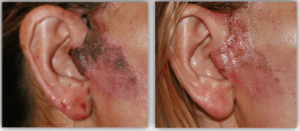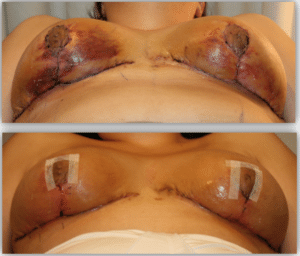“Time is a cruel thief to rob us of our former selves. We lose as much to life as we do to death.” Elizabeth Forsythe Hailey
Living in the modern world becomes more complex and harder as life in the 21st-century becomes faster and faster. We are burdened with responsibilities and distracted by an interminable onslaught of media in all forms including the capricious internet. It seems as if everything is competing for our attention in one way, shape or form while stealing precious time we could otherwise devote to family, friends and simply to our own selves. Therefore, when it comes to saving time, the need to heal quickly after any cosmetic procedure is almost rapacious.
Unfortunately, there is no magic pill or formula to bypass the post operative inflammation of bruising, swelling and discomfort at this current time. As one of the top plastic surgeons in Beverly Hills, Dr. HAWORTH has seen a thing or two about how patients heal after the thousands of surgeries he has performed over two decades. As a facial plastic surgery expert, he has performed thousands of primary and revision rhinoplasties, brow lift, facelifts and blepharoplasties not to mention the breast implant operations throughout his career and has realized there are things you can do both at home and in the clinical setting to accelerate your healing.
First of all, it is a good idea to focus on whole foods as much as possible while avoiding processed ones as the former will contain the highest levels of vitamins and amino acids your body will need for a speedy recovery. Amino acids help wounds heal faster and obviously, these are found in chicken, meats, egg whites, fish, brown rice, healthy nuts like walnuts and almonds or sunflower seeds. Taking supplemental vitamin C in your diet while increasing zinc in your diet can be helpful. Instead of taking vitamin C for a bottle, you can eat strawberries, papayas and citrus fruits which are great sources of vitamin C. 500-1000mg is the usual amount that is taken. Zinc is found in oysters which have one of the highest levels of zinc found in any food. If you are going to take a supplement, 15 mg of zinc daily is the recommended amount but you can increase your zinc intake to 30–50 mg for 2 weeks before and 2 weeks after surgery, using zinc picolinate.
Beverly Hills plastic surgeon Dr. Haworth also recommends these useful supplements to take in preparation for your surgery include:
B12 and Iron – Iron and B12 both aid bone marrow in forming new blood cells, so incorporate foods like fish and eggs.
Vitamin B6 250mg, twice a day for a week, starting 3 days after surgery. This helps reduce post-surgical fluid retention, such as swelling of the face, hands, feet or legs. With B6, you can experience substantial reduction within 24 to 48 hours.
CoQ10- Surgical trauma (particularly from cardiac surgery) causes an increase in free radicals, which damage cellular function. For this reason alone, you should take at least 50 mg of CoQ10 as part of your daily routine before your cosmetic surgery and 100–200 mg/day for at least 4 weeks after.
Fiber and probiotics – This combination helps boost the immune system and also keeps your digestive tract moving along. Eating yogurt with granola is just one easy way to get a serving of both fiber and probiotics! When choosing a probiotic, consider one that contains acidophilus and bifida bacteria (follow label instructions for dosage). Surgical patients often receive oral or intravenous antibiotics in the hospital, which creates the potential for yeast infections, digestive disturbances and diarrhea. A probiotic may help counteract these problems.
One amino acid that has been shown to speed with healing is glutamine and a study from Harvard and Dave showed that it shortened healing by about four days. Apart from supplements, glutamine can be found in beef, chicken and all types of fish. Dairy products such as cheese, milk, yogurt and eggs contain glutamine with ricotta and cottage cheese being the two richest sources. Vegetarians can find glutamine in beans and lentils. For most of his patients, facial plastic surgery specialist Haworth recommends supplemental Arnica Montana, Bromelain/ Bromezyme (this pineapple enzyme helps prevent blood clots, aids digestion while decreasing inflammation and pain after surgery) and Pycnogenol/Pine bark. This triumvirate is aimed at reducing bruising, soreness and inflammatory edema. Apart from the above, many patients inquire about any other additional medications, exercises or procedures that can be done to maximally reduce their healing times after surgery. Of course, all patients should ask their individual physicians or surgeons about their own personalized recommendations to speed up recovery which is beyond the scope of this post.Bioptron® Light employs a combination of polarized infrared and visible light (480nm-3400nm) considered beneficial in the treatment of wound problems and injuries by exerting its effect at the cellular level. Bioptron® therapy has a low energy density (fluency) of 2.4 J/cm2 at a distance of 10 cm and can penetrate the skin up to 2.5 cm.



It has been used effectively in the treatment of burns, pressure sores, leg ulcers, wounds, pain and recently, postoperative healing. Dr Haworth have found it very useful in his clinic to reduce both swelling and bruising. Supporting his experience, other plastic surgeons here and abroad have noted decreased resolution times of eccymosis and edema following surgery by over 33% with Bioptron®. Indeed, it has been used to also reverse the course of cutaneous necrosis as well as accelerate granulation of open wounds, either alone or in conjunction with hyperbaric oxygen therapy (HBOT).
Hyperbaric oxygen therapy involves breathing pure oxygen in a pressurized room or tube. It is a well-established treatment for decompression sickness, a hazard of scuba diving. Other conditions treated with HBOT include serious infections, bubbles of air in blood vessels and non-healing wounds as a result of diabetes or radiation injury.
In a HBOT chamber, the air pressure is increased to 3 times higher than normal air pressure and under these conditions, your lungs can gather more oxygen than would be possible breathing pure oxygen at normal air pressure. However, there is some confusion about what actually is “true” HBOT. Those employing “soft” tent like enclosures are essentially useless since they are unable to obtain a true hyperbaric environment of 2 to 4 atmospheres absolute (ATA). In fact, these personal or home-use “hyperbaric” tent enclosures can usually only attain a pressure of 1.3 ATA. There is a debate as to how much and how many treatments are necessary to speed up recovery after plastic surgery. While most plastic surgeons perhaps recommend one preoperatively and at least 3 to 5 postoperatively, experts in the field say one needs at least 15 to 20 treatments in order to see significant results. In my experience, 3 to 5 treatments are all that is necessary to achieve the more modest goals of reducing edema, bruising and discomfort resulting from elective plastic surgery.
After certain surgeries, body contouring plastic surgery expert Dr Randal Haworth may also recommend selective lymphatic massage/drainage to resolve edema (swelling) of the extremities, particularly after liposuction or liposculpture.
The above aforementioned vitamins, nutritional supplements and clinical interventions may not be the panacea to surgical healing which comes in a pill form, but they certainly are a step in the right direction in making recovery from any procedure as smooth as possible in 2017.
Dr Randal Haworth2017 Beverly Hills
